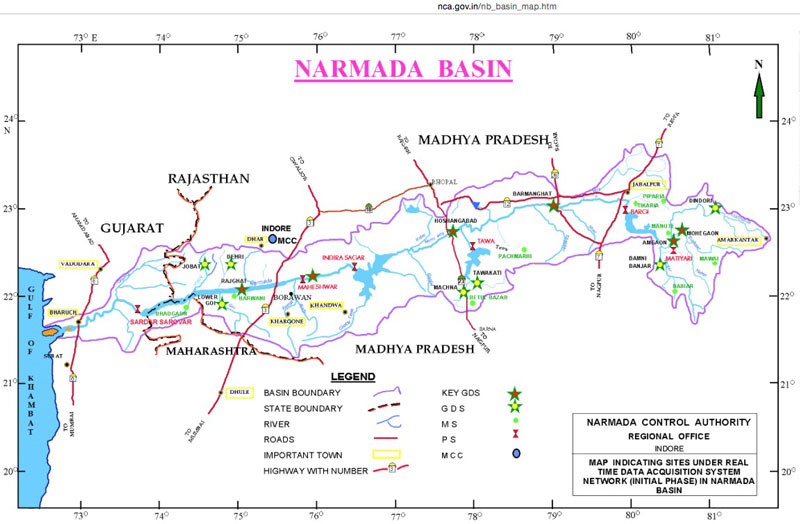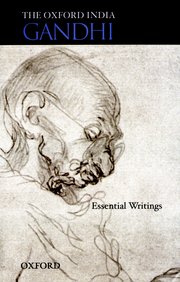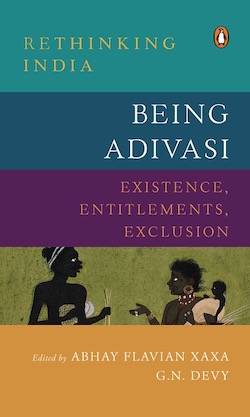
Memories of life in a remote Bhil hamlet on the Narmada river >>
“Those displaced, who are the Scheduled Tribes, belong to the Bhil, Bhilala, Pavra, Tadvi, and Vassawa ethnic groups [of] Gujarat, Madhya Pradesh, and Maharashtra.”
Source: Development and Dispossession in the Narmada Valley >>
The Narmada Control Authority (NCA) has been setup under the final orders and decision of the Narmada Water Disputes Tribunal (NWDT) as a machinery for implementation of its directions and decision. The authority started functioning from 20th December, 1980. | Learn more >>
Source: Narmada Control Authority
Address: https://nca.gov.in/aboutus_ind.htm
Date Visited: 22 October 2020
Submergence Details:
- The Sardar Sarovar Project (SSP) at FRL 138.68m (455 ft.) will affect 244 villages in the 3 States which includes 192 in Madhya Pradesh, 19 in Gujarat and 33 in Maharashtra. Out of 244 villages, 4 are getting fully submerged and remaining are getting partially submerged.
- The Sardar Sarovar Project (SSP) at FRL 138.68m (455 ft.) will affect 48269 families in the 3 States which include 39369 PAFs in Madhya Pradesh, 4737 PAFs in Gujarat and 4163 PAFs in Maharashtra.
- The total land affected in the 3 states is 37533 ha. which includes 11279 ha. agricultural land.
Source: Narmada Control Authority
Address: http://nca.gov.in/rnr_index.htm
Date Visited: 22 October 2020

More about the Bhil and Bhilala communities >>
Pithora arts and crafts | Textile >>
Simple ways of life
It was almost three decades ago and I have only very hazy memories of the trip. We, a batch of university students, accompanied our Anthropology professor to a remote tribal village in northern Maharashtra, to study the impact of the controversial construction of giant dams being built on the Narmada river. […]
Life in the hamlet, home to a small number of families of the Bhil tribe, was simple. There were then no roads in the area, and communication with the world outside was strictly limited. The jungles and mountains acted as a barrier to the infiltration of outside influences, which meant that the denizens of the hamlet lived much as their ancestors must have. Bhil men donned just a small loin cloth, woven at home, and the women left their torsos uncovered. There were no shops in the area, indicating that the Bhil villages were largely self-sufficient.
By urban standards, the Bhils were poor but not impoverished. Very few Bhils worked outside their villages, and most of them seemed to be content with how they were. They grew whatever they required, and their methods of cultivation were simple: they scattered the seeds on the slopes of the hills and let them grow naturally. The forests around were rich in fruits, vegetables and herbs, which were collected.
Few outsiders ever bothered to come to the Bhil areas. And that was all for the good because it meant that the Bhils could carry on with their lives much as they had for centuries. There were hardly any schools in the area, for what need, I thought, was there to study books in an alien tongue which would inevitably alienate them from their own culture?
And of course, thankfully, there was no TV, which has played such havoc with local cultures and has triggered off uncontrollable consumerism even in isolated communities.
After a tiring day’s work in the fields, men and women would gather in a communal hut, where youngsters would sing and dance together to the throbbing of drums. Others would prepare a drink made of the mahua flower, served in leaf cups. Yet others would sit around and smoke mahua flowers mixed with tobacco in giant pipes.
The Bhils of the area practiced their own unique religion, a form of animism and ancestor worship with a heavy dose of magic. But it was clear even at that time that their ancient religious tradition would soon disappear: many Bhils in the area had become devotees of wandering Hindu sadhus and Christian missionaries. Soon, their religious tradition would be looked down by others as ‘primitive’. […]
They had no faith in the promises of the government of being suitably rehabilitated. In any case, money probably didn’t count much for them. At the same time, the inhabitants of the hamlet probably suspected that their opposition to the dam was futile and must have known that, like thousands of other tribals displaced in the name of ‘development’, they might soon have to flee their homes once the dam came up.
And for all I know, with the dam now firmly in place, their village might now have been completely wiped off the map of the world, sunk deep in the swirling waters of the Narmada, its denizens being reduced to manual labourers in some dusty, nondescript Indian town.
Source: “Simple ways of life” by Yoginder Sikand (Deccan Herald, 23 December 2012)
Address : https://www.deccanherald.com/content/300193/simple-ways-life.html
Date Visited: 25 February 2021
The Narmada and its 30 big dams, the Sardar Sarovar in particular, have for long been a matter of prestige for the government. […]
According to the rehabilitation package, each of the displaced families are entitled to two hectares of land. Male members of a family who are over 18 are also eligible to get these two hectares in their own right. The submergence area of the Sardar Sarovar extends into Madhya Pradesh and most of the oustees are from that State. In fact, additional submergence from increasing the height will affect villages in Madhya Pradesh more than the other States. […]
Source: “Height of controversy” by Lyla Bavadam (Frontline Magazine, 19 September 2014)
Address: https://www.frontline.in/the-nation/height-of-controversy/article6364780.ece
Date Visited: 22 October 2020
There is no other way but to redefine “modernity” | Read the full Acceptance speech by Medha Patkar and Baba Amte here >>
More than one hundred and fifty thousand people in and around the bountiful and peaceful valley of Narmada are forced to raise a struggle of life and death. […]
They are tribal and poor people, farmers and labourers, fishermen and forest produce gatherers, small enterprisers and artisans, belonging to about 250 communities. They are socially and economically disadvantaged. The tribal – adivasis, the aborigines – mostly living far from the market and centres of economic and political power, and yet self-reliant, least monetised, and integrated with the forest, a rich natural resource-base; their life-support. Those in the plains have prime agricultural land support. They are united through the generations by the rich habitat, the Narmada Valley, and now by sharing an unprecedented catastrophe. Today they have risen as one man to fight the gigantic forces representing the short-sighted power-hungry politicians, the self-centered supine bureaucracy, the rapacious contractors, neo-colonial lending agencies and the vulgar consumerist elite population. […]
The mute nature and powerless inhabitants of the Valley never were among the parties. […] while 150 000 people are recognised as ‘the oustees’, not less than another 200 000 to be affected by canals, infrastructure or sanctuary and afforestation. […]
Similar struggles are on in the other valleys and hills. Tehri and Suvarnarekha in India, Kedung Ombo in Indonesia, Bulbino in Brazil. People in the rural and tribal regions are compelled to justify their survival; establish their right to the traditional generations-old source of livelihood; protect their properties, community life and culture from the encroachers – not just the colonialist consumerist societies outside and within their nation state, but also the State itself as the wildest and the biggest encroacher. […]

Library copies: Worldcat.org >>
Gandhian social movement >>
The perspective which the [Right Livelihood] Award propagates is clear from its motto [“committed to peace, justice and sustainability for all“]. The most respected words of the leader of our beloved country, India, Mahatma Gandhi: “The world has enough for everyone’s need but not for anyone’s greed”.
The World today is facing a challenge that is becoming increasingly acute day by day. For years and decades a few dominant countries and a small elite population in each developing country have ruled the world, exploited the human and material resources, in their favour. […]
There is no other way but to redefine “modernity” and the goals of development, not to narrow it to “environment” but to widen it to a sustainable equitable just society based on harmonious non exploitative relationship between human being to human being, and human being to nature. We cannot be either politically naive or apathetic or playing the unseen hand of free economy. […]
Non violent opposition to the uncivilized traditions of big dams and mega projects like Narmada, with our souls converted into weapons, ready to defend our way of life, our bodies are flushed out, can be our humble attempt not just to save the eternal Valley but the questions of humankind. […]
Source: Acceptance speech by Medha Patkar and Baba Amte (Narmada Bachao Andolan), Laureates of the 1991 Right Livelihood Award (“a courage-powered community for social change committed to peace, justice and sustainability for all)
URL: https://rightlivelihood.org/speech/acceptance-speech-medha-patkar-and-baba-amte-narmada-bachao-andolan/
Date visited: 11 March 2022
[Bold typeface added above for emphasis]
Up-to-date reports by Indian journalists and commentators
To search Indian periodicals, magazines, web portals and other sources safely, click here. To find an Indian PhD thesis on a particular tribal community, region and related issues, click here >>
Search tips
Combine the name of any particular state, language or region with that of any tribal (Adivasi) community.
Add keywords of special interest (music, poetry, dance just as health, sacred grove and biodiversity); learn about the rights of Scheduled Tribes such as the “Forest Rights Act” (FRA); and the United Nations “Declaration on the Rights of Indigenous Peoples”, “Universal Declaration of Human Rights”, “women’s rights”, or “children’s right to education”.
Ask a question that includes “tribal” or “Adivasi”, for instance: “Adivasi way of life better?” (or “tribal way of life worse?”)
Specify any particular issue or news item (biodiversity, bonded labour and human trafficking, climate change, ecology, economic development, ethnobotany, ethnomedicine, global warming, hunter-gatherers in a particular region or state, prevention of rural poverty, water access).
For official figures include “scheduled tribe ST” along with a union state or region: e.g. “Chhattisgarh ST community”, “Himalayan tribe”, “Scheduled tribe Tamil Nadu census”, “ST Kerala census”, “Particularly Vulnerable Tribal Group Jharkhand”, “PVTG Rajasthan”, “Adivasi ST Kerala”, “Adibasi ST West Bengal” etc.
In case the Google Custom Search window is not displayed here try the following: (1) toggle between “Reader” and regular viewing; (2) in your browser’s Security settings select “Enable JavaScript” | More tips >>
Note: hyperlinks and quotes are meant for fact-checking and information purposes only | Disclaimer >>

Search publications via Indian publishers & libraries:
Virginius Xaxa & Ganesh Devy or G.N. Devy >>
See also
Forest Rights Act (FRA) | Legal rights over forest land
Health and nutrition | Recommendations by the Expert Committee
People’s Archive of Rural India (PARI) | RuralIndiaOnline.org
States along the Narmada river’s course (source to Arabian Sea):
Madhya Pradesh | Maharashtra | Gujarat